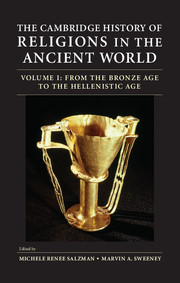Book contents
- Frontmatter
- Contents
- List of Figures and Maps
- List of Contributors
- List of Abbreviations
- Acknowledgments
- Introduction to Volumes I and II
- Introduction to Volume I
- Part I Mesopotamia and the Near East
- Part II Egypt and North Africa
- Part III Greece and the Eastern Mediterranean
- Part IV The Western Mediterranean and Europe
- Suggestions for Further Reading
- General Index
- Index of Citations
- Frontmatter
- Contents
- List of Figures and Maps
- List of Contributors
- List of Abbreviations
- Introduction to Volume II
- Part I Iran and the Near East
- 1 Religion in Iran
- 2 Creating Local Religious Identities in the Roman Near East
- 3 Judaism in Palestine in the Hellenistic-Roman Periods
- 4 Post-70 Judaism in Judea and the Near East
- 5 Christianity in Syria
- Part II Egypt and North Africa
- Part III Greece and Asia Minor
- Part IV Italy, Roman Gaul, and Spain
- Suggestions for Further Reading
- General Index
- Index of Citations
2 - Creating Local Religious Identities in the Roman Near East
from Part I - Iran and the Near East
Published online by Cambridge University Press: 05 October 2013
- Frontmatter
- Contents
- List of Figures and Maps
- List of Contributors
- List of Abbreviations
- Acknowledgments
- Introduction to Volumes I and II
- Introduction to Volume I
- Part I Mesopotamia and the Near East
- Part II Egypt and North Africa
- Part III Greece and the Eastern Mediterranean
- Part IV The Western Mediterranean and Europe
- Suggestions for Further Reading
- General Index
- Index of Citations
- Frontmatter
- Contents
- List of Figures and Maps
- List of Contributors
- List of Abbreviations
- Introduction to Volume II
- Part I Iran and the Near East
- 1 Religion in Iran
- 2 Creating Local Religious Identities in the Roman Near East
- 3 Judaism in Palestine in the Hellenistic-Roman Periods
- 4 Post-70 Judaism in Judea and the Near East
- 5 Christianity in Syria
- Part II Egypt and North Africa
- Part III Greece and Asia Minor
- Part IV Italy, Roman Gaul, and Spain
- Suggestions for Further Reading
- General Index
- Index of Citations
Summary
The attentive visitor to the Fitzwilliam Museum in Cambridge may spot in room 24 a beautiful, large statue in basalt stone that, according to the accompanying label, represents a “syncretistic, Syrian military deity” (Fig. 1). The statue, from the Syrian Hauran region, circa 100km south to southeast of Damascus, was published in the acquisitions guide of the museum but has, to the best of my knowledge, not otherwise been discussed in scholarly literature. In 1979 the Keeper of Antiquities, Dick Nicholls, described it in a slightly longer, unpublished report to the then director of the museum as follows:
This statue, possibly the finest of the Hauran sculptures now surviving, lacks its arms and legs but is otherwise splendidly preserved. The head is that of a goddess wearing drop ear-rings, a splendid late Roman link-in-link chain necklace with animal-head finials and a central medallion and, in her hair, the form of the Greek stephanē that had by Roman times evolved into a kind of crown worn by certain goddesses such as Venus and Diana…. Her hair is rendered in one of the developments from the much older Hellenistic “melon style” that became widespread in the eastern Roman provinces in the 3rd century AD, and more especially in the later part of that century. The figure wears a military cloak, fastened at the right shoulder by a brooch with ivy-leaf pendants hanging by chains, and a breastplate. The latter terminates below the androgynous breasts which mark the transition from a female head to a male body and is worn without shoulder-guards. The preserved shoulders and struts from the body show that both arms were lowered to the sides. The right arm held a double-bladed battle axe, the blades and top of which are preserved against the right shoulder…. The left arm also held an attribute, of which the only part surviving is the head of a snake that extends over on to the breastplate. Almost certainly, what the statue held was the kerykeion, or herald’s staff, of Hermes, twined with two snakes.
- Type
- Chapter
- Information
- The Cambridge History of Religions in the Ancient World , pp. 54 - 86Publisher: Cambridge University PressPrint publication year: 2013
- 1
- Cited by



